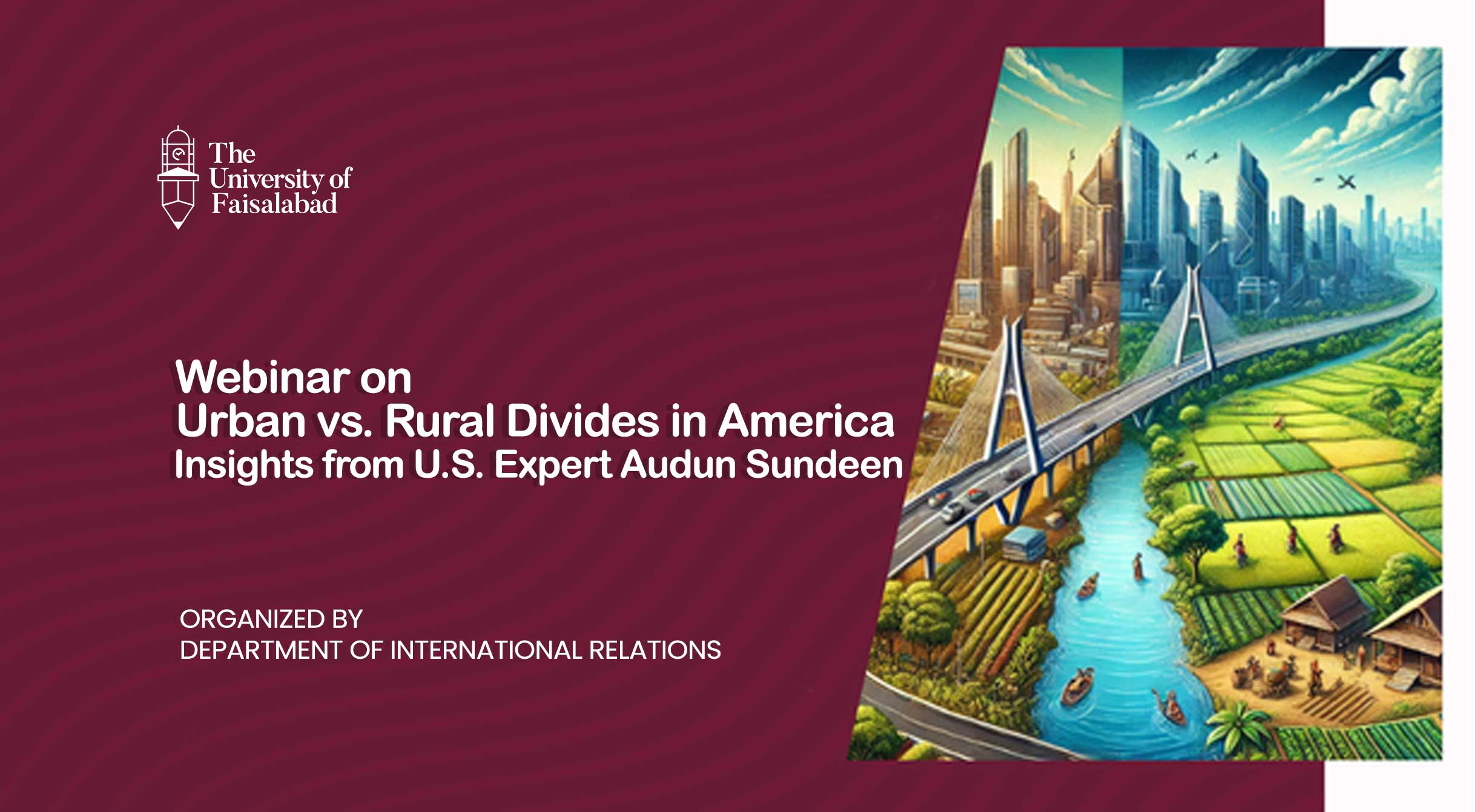Webinar on Urban vs. Rural Divides in America—Insights from U.S. Expert Audun Sundeen
Introduction
On a recent academic occasion, the Department of International Relations at The University of Faisalabad (TUF), under the capable leadership of Professor Dr M Ashfaq, Dean of the Faculty of Management Studies, hosted a compelling online seminar entitled “Urban vs. Rural Divides: Societal Stratification, Cultural Shifts, and Their Influence on American Economic and Foreign Policy.” The distinguished speaker was Audun Sundeen (USA), an expert whose perspectives helped shed light on the complex and layered urban-rural dynamics in contemporary America.
In this article, we explore key themes raised during the webinar, reflect on their relevance for global and Pakistani contexts, and consider how the urban-rural divide affects economic policy, culture, and geopolitics.
Understanding the urban-rural divide in America
According to Sundeen’s presentation, the divide between urban and rural America is not simply a matter of geography—it encompasses social class, cultural values, infrastructure, economic opportunity, and political attitude. He highlighted three core dimensions:
Social and economic stratification
Rural areas often lag behind urban centres in job opportunities, access to healthcare, educational infrastructure, and digital connectivity. Many rural communities feel left behind by economic modernisation and demographic shifts. These structural imbalances feed into a sense of marginalisation and cultural difference, which in turn influence voting behaviour, social cohesion, and identity.
Cultural shifts and identity politics
Sundeen emphasised how values and cultural norms differ markedly between urban and rural populations. Urban regions, often more diverse and dynamic, might embrace rapid change, innovation and multiculturalism. Rural regions, by contrast, may prize tradition, a slower pace of life, and local community ties. These distinct world-views shape attitudes toward national policy, social welfare, and globalisation.
Impact on national and foreign policy
What happens internally in the U.S. is not isolated. The urban-rural divide influences how America formulates its economic priorities, foreign policy, and strategic orientation. For instance, regions feeling left out may support populist or nationalist agendas. Policy-makers must therefore account for internal cohesion if the country is to project unified influence abroad.
Key takeaways from the webinar
Here are some of the standout insights from the session and what they mean for students, academics, and policy-makers.
1. Infrastructure and digital divides matter
One major point was connectivity—both physical and digital. Rural regions often face weaker road, rail, broadband and healthcare infrastructure. This undercuts economic growth and social inclusion. Without bridging these gaps, policy-makers risk reinforcing the divide.
2. Demographic and economic change is accelerating
Urbanisation, migration from rural to urban areas, and changes in employment (from manufacturing or agriculture toward service and knowledge sectors) are shifting the landscape. Rural areas may lose population and vitality, which compounds the challenge of maintaining viable local institutions and services.
3. Cultural and value-based differences translate into policy outcomes
Sundeen showed that rural-urban differences aren’t merely geographic—they map into preferences around welfare, regulation, trade, immigration and foreign engagement. For example, a more rural electorate might favour protectionist trade policies or cautious foreign entanglements, while more urban constituencies may favour open trade and global cooperation.
4. Bridging the divide is essential for national coherence
If a large segment of the nation feels left behind, it undermines social trust, political stability and the ability to navigate global challenges. Strengthening rural areas through targeted investment and inclusive policy helps affirm that all citizens matter—and that strengthens a country’s standing externally as well.
Why this matters globally and for Pakistan
Although the focus of the webinar was the U.S., the lessons resonate globally—and particularly for countries like Pakistan.
- In Pakistan, the urban-rural divide is marked in terms of access to education, healthcare, infrastructure, digitisation, and employment. Recognising the cultural as well as economic dimensions of this divide is vital.
- With Pakistan’s economy and society undergoing rapid change (urbanisation, youth bulge, digital expansion), policy-makers must ensure that rural districts are not left behind.
- The global dimension: internal cohesion affects how a country presents itself internationally. A nation deeply divided internally may struggle to formulate a consistent foreign policy or represent itself effectively on the world stage.
Implications for higher education and scholars
For students and academics at institutions like The University of Faisalabad, the webinar underscores several opportunities:
- Research topics: locally-relevant studies on urban-rural divides in Pakistan—how they affect education, migration, digital access, culture and political behaviour.
- Curriculum: incorporating comparative studies (USA vs Pakistan) to understand how societies manage internal divides and what lessons apply across contexts.
- Dialogue and engagement: As the webinar showed, engagement (Q&A, faculty-student discussion) enriches learning. Institutions should encourage these cross-disciplinary and global exchanges.
Concluding reflections
The webinar by Audun Sundeen offered a timely and rich overview of how urban-rural divisions shape not only domestic life in America but also economic policy and global posture. For developing countries and higher-education institutions, it provides a compelling model: understand the local divides, bridge infrastructure and cultural gaps, and integrate global lessons into domestic policy and academic discourse.
In closing: to achieve inclusive growth and coherent global engagement, societies must pay attention to the places and people that risk being left behind. Internal strength is the foundation for external influence.

